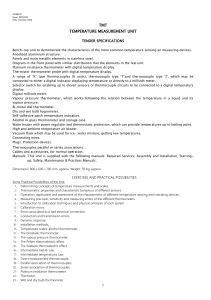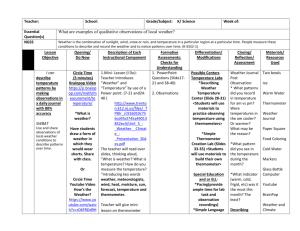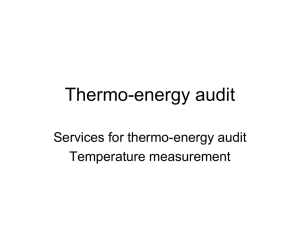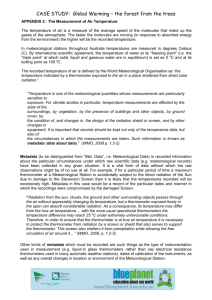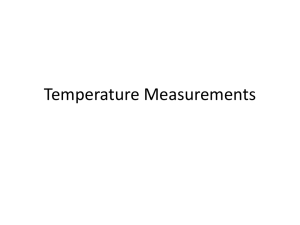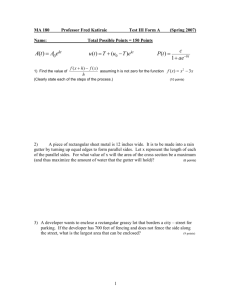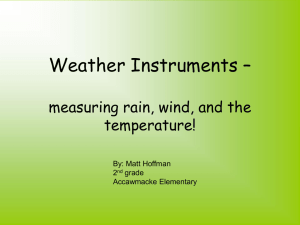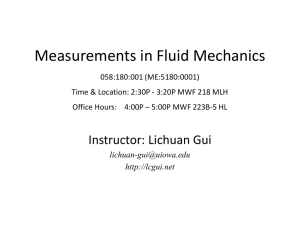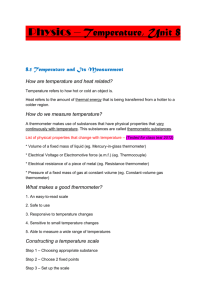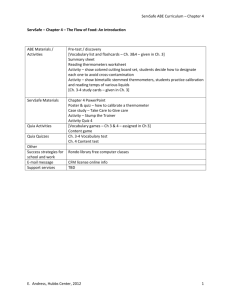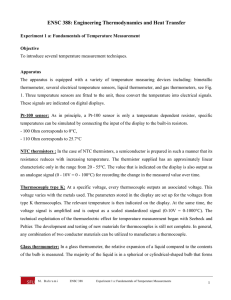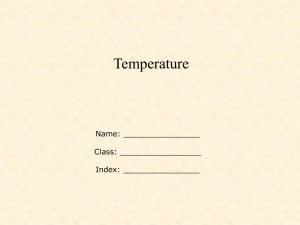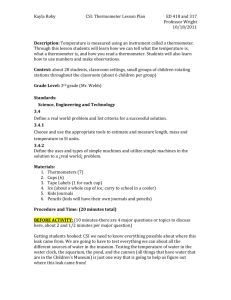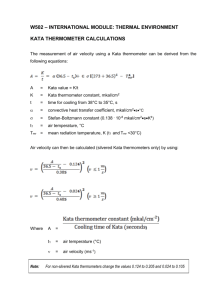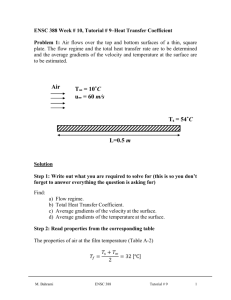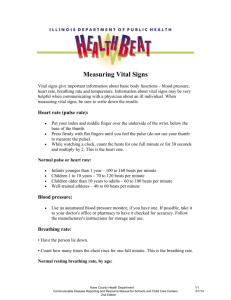Fundamentals of temperature measurements
advertisement
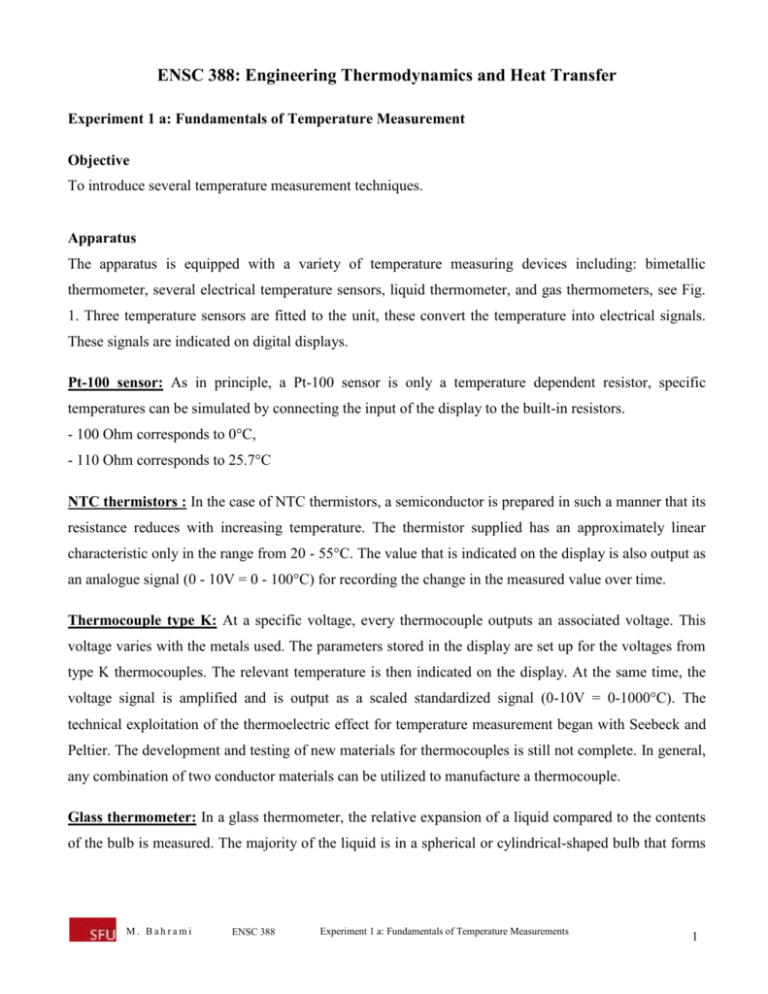
ENSC 388: Engineering Thermodynamics and Heat Transfer Experiment 1 a: Fundamentals of Temperature Measurement Objective To introduce several temperature measurement techniques. Apparatus The apparatus is equipped with a variety of temperature measuring devices including: bimetallic thermometer, several electrical temperature sensors, liquid thermometer, and gas thermometers, see Fig. 1. Three temperature sensors are fitted to the unit, these convert the temperature into electrical signals. These signals are indicated on digital displays. Pt-100 sensor: As in principle, a Pt-100 sensor is only a temperature dependent resistor, specific temperatures can be simulated by connecting the input of the display to the built-in resistors. - 100 Ohm corresponds to 0°C, - 110 Ohm corresponds to 25.7°C NTC thermistors : In the case of NTC thermistors, a semiconductor is prepared in such a manner that its resistance reduces with increasing temperature. The thermistor supplied has an approximately linear characteristic only in the range from 20 - 55°C. The value that is indicated on the display is also output as an analogue signal (0 - 10V = 0 - 100°C) for recording the change in the measured value over time. Thermocouple type K: At a specific voltage, every thermocouple outputs an associated voltage. This voltage varies with the metals used. The parameters stored in the display are set up for the voltages from type K thermocouples. The relevant temperature is then indicated on the display. At the same time, the voltage signal is amplified and is output as a scaled standardized signal (0-10V = 0-1000°C). The technical exploitation of the thermoelectric effect for temperature measurement began with Seebeck and Peltier. The development and testing of new materials for thermocouples is still not complete. In general, any combination of two conductor materials can be utilized to manufacture a thermocouple. Glass thermometer: In a glass thermometer, the relative expansion of a liquid compared to the contents of the bulb is measured. The majority of the liquid is in a spherical or cylindrical-shaped bulb that forms M. Bahrami ENSC 388 Experiment 1 a: Fundamentals of Temperature Measurements 1 the thermometer’s actual sensing element and the bulb opens into the long, thin glass capillary tube. The volume of the medium in liquid thermometers changes with temperature as follows: Vt = V0 (1 + γ∆T) (1) where Vt is the volume at temperature T, V0 is the volume at 0°C, and γ is the coefficient of thermal expansion. Figure 1: Details of the experimental setup. Bimetallic thermometers exploit the differential expansion of two different materials to indicate the temperature. Two or more layers of different materials are rolled together, see Fig. 2. During this process, different shapes can be manufactured depending on the application. One end of the sensor is firmly anchored; the other is coupled to a transmission gear or directly to a display device. Variation of the temperature results in expansion of the metallic coil which itself leads to rotation of the free end. M. Bahrami ENSC 388 Experiment 1 a: Fundamentals of Temperature Measurements 2 Figure 2: Principle of operation of a bimetallic thermometer The gas thermometer is one of the most important devices used to realize the thermodynamic temperature scale over a very wide temperature range almost down to absolute zero. Using this method, the change in the pressure or volume of a gas is measured as a function of temperature in accordance with the ideal gas equation: 𝑃𝑉 =𝑚𝑅𝑇 (2) Procedure In order to compare the accuracy and the required time for getting accurate reading in different two known temperatures should be measured with all different thermometers. Here you have to measure the temperatures of water-ice mixture and boiling water. Therefore, put some ice cubes in the insulated flask and fill it with water. Insert thermometers inside the flask and wait until the steady state condition is reached. Measure the time required for reaching the steady state condition in each case. Next, fill the small vessel with water and put it on top of the heater. Once the water comes to complete boiling, insert the thermometers and measure the steady state temperature and the required time. Compare the measured temperatures with the values reported in thermodynamic tables and comment on the accuracy and settling time (required time to reach to steady state) of each thermometer. M. Bahrami ENSC 388 Experiment 1 a: Fundamentals of Temperature Measurements 3 Discussions 1) Explain different types of thermocouples and discuss on the range of applicability. 2) What are the Seebeck and Peltier effects? 3) According to the experiment which thermometer do you recommend? Why? 4) Some thermometer shows deviation from expected data. Why? Table 1: Water-ice and boiling-water temperature data water-ice mixture Boiling water Pt-100 sensor NTC thermistors Thermocouple type K Glass thermometer Bimetallic thermometers The gas thermometer M. Bahrami ENSC 388 Experiment 1 a: Fundamentals of Temperature Measurements 4


